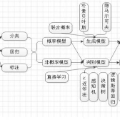Probabilistic models based on continuous latent spaces, such as variational autoencoders, can be understood as uncountable mixture models where components depend continuously on the latent code. They have proven to be expressive tools for generative and probabilistic modelling, but are at odds with tractable probabilistic inference, that is, computing marginals and conditionals of the represented probability distribution. Meanwhile, tractable probabilistic models such as probabilistic circuits (PCs) can be understood as hierarchical discrete mixture models, and thus are capable of performing exact inference efficiently but often show subpar performance in comparison to continuous latent-space models. In this paper, we investigate a hybrid approach, namely continuous mixtures of tractable models with a small latent dimension. While these models are analytically intractable, they are well amenable to numerical integration schemes based on a finite set of integration points. With a large enough number of integration points the approximation becomes de-facto exact. Moreover, for a finite set of integration points, the integration method effectively compiles the continuous mixture into a standard PC. In experiments, we show that this simple scheme proves remarkably effective, as PCs learnt this way set new state of the art for tractable models on many standard density estimation benchmarks.
翻译:基于连续潜在空间的概率模型,如变分自编码器,可以被看作是一种基于无限个混合组件的模型,其中各个组件会连续地依赖于潜在编码。这些模型已经被证明是表达丰富的生成式和概率建模工具,但是它们难以进行可解释的概率推断,例如计算表示的概率分布的边际和条件分布。与此相反,可解释的概率模型,如概率电路(*PCs)可以被看作是一种分层的、具有离散混合组件的混合模型,因此能够高效地执行准确的推断,但在性能上往往不如基于连续潜在空间的模型。在本文中,我们研究了一种混合方法,即具有小的潜在维度的可解释模型的连续混合方法。虽然这些模型在分析上是不可解的,但它们很适合基于有限积分点的数值积分方案。只要积分点足够多,近似就近乎精确。此外,对于有限的积分点集,积分方法可以将连续的混合编译成标准的概率电路。在实验中,我们展示了这种简单方案的出色效果,这种方式学习的电路在许多标准密度估计基准测试数据集上取得了新的最佳结果。




